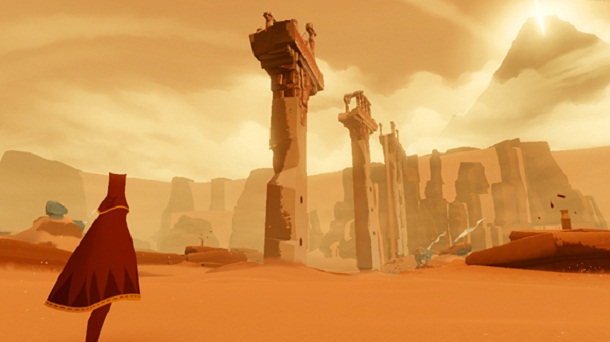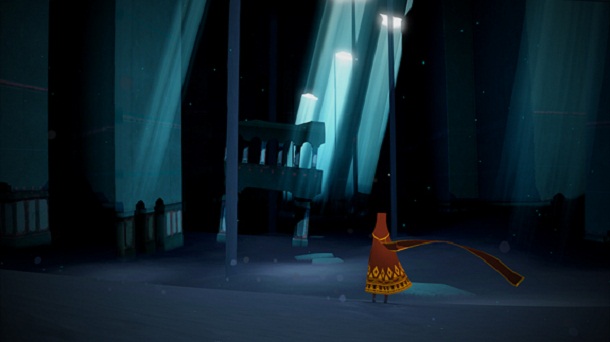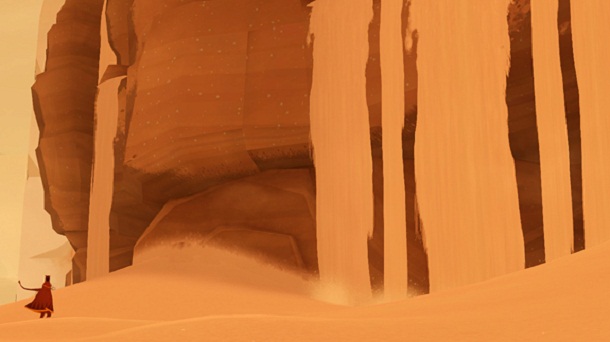Journey Preview
![]() Some games are visual spectacles, giving the player something to feast their eyes on and making them sit back in awe at the sheer amount of polygons the developers were able to squeeze into their game. Some games however, aren’t that special in terms of their polygon count, but what sets them apart from the rest of the competition is the vision of the creators. Some games should be held aloft in the ongoing argument of video games as art; Journey is one of those games.
Some games are visual spectacles, giving the player something to feast their eyes on and making them sit back in awe at the sheer amount of polygons the developers were able to squeeze into their game. Some games however, aren’t that special in terms of their polygon count, but what sets them apart from the rest of the competition is the vision of the creators. Some games should be held aloft in the ongoing argument of video games as art; Journey is one of those games.
The first thing that players will notice if they are lucky enough to have access to the beta of Journey is that there’s almost no instructions as to what you’re expected to do. Most games will go into long instructional tutorials about what you’re going to be doing with your time in the game. Collect these things, go here, finish the level and collect the rewards; not with Journey. In Journey you’re given the basic controls in the form of simple images and you’re then left to figure everything out for yourself.

It’s a little daunting at first, not knowing what you’re supposed to be doing, but whether it’s a primal instinct or just years of video game logic crammed into the back of most players’ skulls, it doesn’t take long to figure out that you’re supposed to go in the general direction of the massive pillars of light. You’re never told this, you have to figure it out yourself, but when you do finally work it out there’s a sense of satisfaction that is very difficult to replicate in most games. The controls themselves are simple, tilt the controller to move the camera (or use the right analog stick if you’d prefer), use the left analog stick to move the character, and then just use the ‘X’ and ‘O’ buttons to perform the actions that you’ll be using. That’s literally all you need to know, the rest of it will just come to you.
After playing the entirety of the beta multiple times, it’s still difficult to nail down the exact genre that Journey is trying to place itself into. Parts of it feel like an action adventure title, while other parts feel like a puzzle game. Whichever genre it’s trying to fit into in the video game world, the only genre it truly fits into, without a shadow of a doubt, is art. When people look at “real” art, each individual person will take something different away from it. Different people will look at the same piece of art with their own eyes, and they might notice the brush strokes, while someone else might notice the colour palette used and take something away about that. Journey is the same, while one person might play the game and appreciate the platforming and control scheme, another person might enjoy the simplistic models and earthy tones of the colours used. Another person entirely might feel moved by the plight of the main character, trying to restore some sort of balance in a world clearly gone awry, whereas that story might go over the head of a person sat in the same room. It’s all about how the person viewing the piece of art sees it in their own individual way. With that in mind it’s easy to say that Journey is art; no doubt about it. If someone doesn’t see the art side of the game then that just goes to prove the diversity of the artwork itself.

The main gameplay of Journey revolves around getting to the end of a certain area, which is designated by a glowing pillar of light. To do that you’ll need to activate certain areas of the game world which look like long cloths fluttering gently in the wind. It takes a little bit of trial and error in order to work out how to do these things, but that’s certainly part of the fun. Figuring out what things you can collect and what they do will give you great satisfaction, simply because you’ve worked it out for yourself instead of being told what to do. The cutscenes are also a little confusing at first, as there are no words at all, only a set of images, and the player is expected to figure out what’s going on and what needs to be done in order to rectify things. While these cutscenes certainly feel a little strange to begin with, it won’t be long until most players are seeking out the areas that need to be activated in order to see more of them. The more you see, the easier the whole story is to understand, and it’s a story that begs to be understood.
Upon completion of the beta it’s easy to understand why most players will want to just start the game over again instantly; I did. I wanted more of the Journey, I wanted to know what was going to happen in the world that I’d instantly found myself enveloped in, and when the game finally does come out you can rest assured that I’ll be one of the thousands of people that will be downloading it on day one. Journey is a beautiful game that plays well and encourages the player to explore the area and work things out for themselves. There aren’t many games out there at the minute that ask that of the player and it’s something that’s very refreshing to see.

The art style is stunning and looks like something straight out of one of those artsy coffee table books. The music, something which I haven’t even talked about in this preview, is serene, calming, and entirely enjoyable from beginning to end, helping to set the tone of the game as much as the art does. Journey was a game that everybody seemed to sit up and take notice of at E3 and after finally being able to get my hands on it, it isn’t difficult to see why.
Journey is due to be released exclusively for PlayStation Network later this year.




